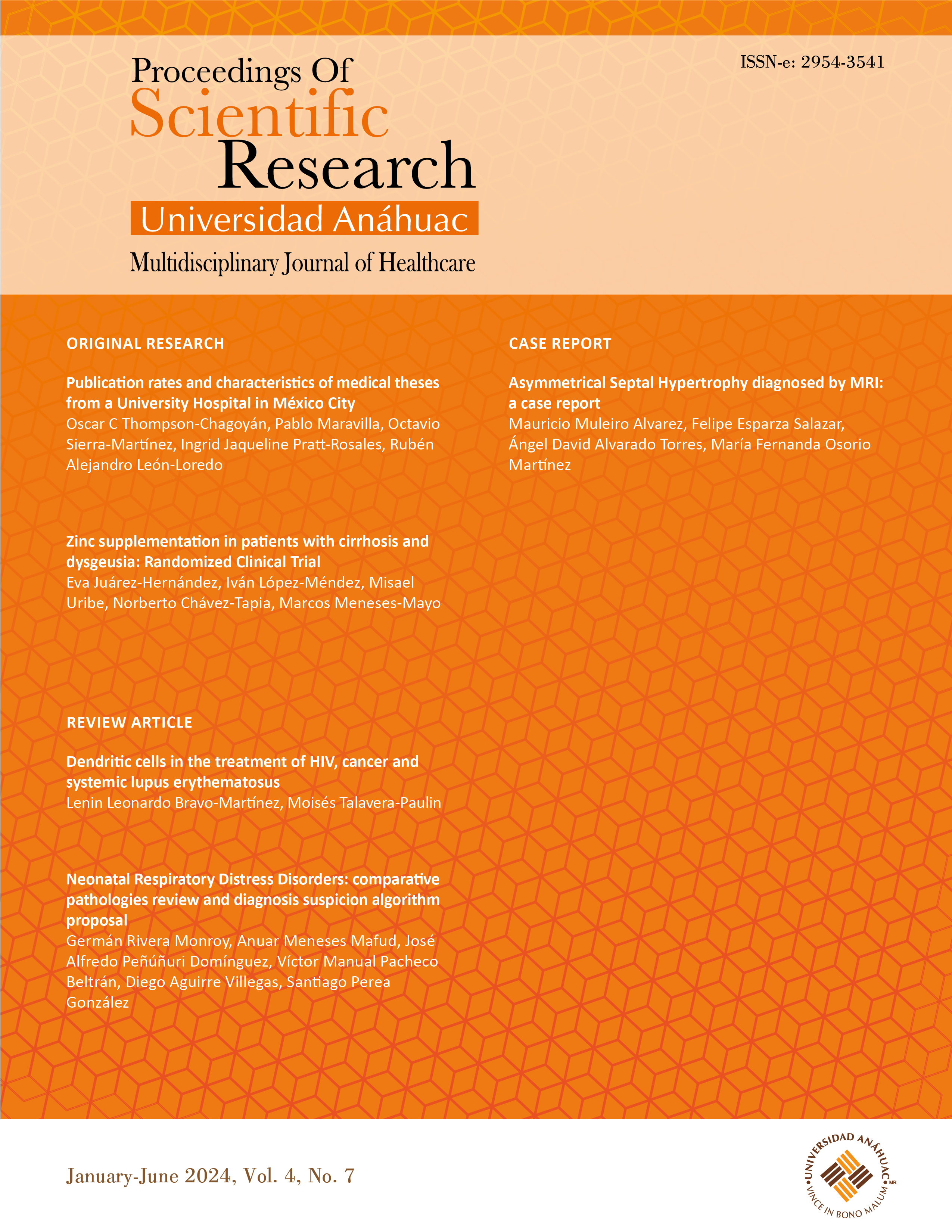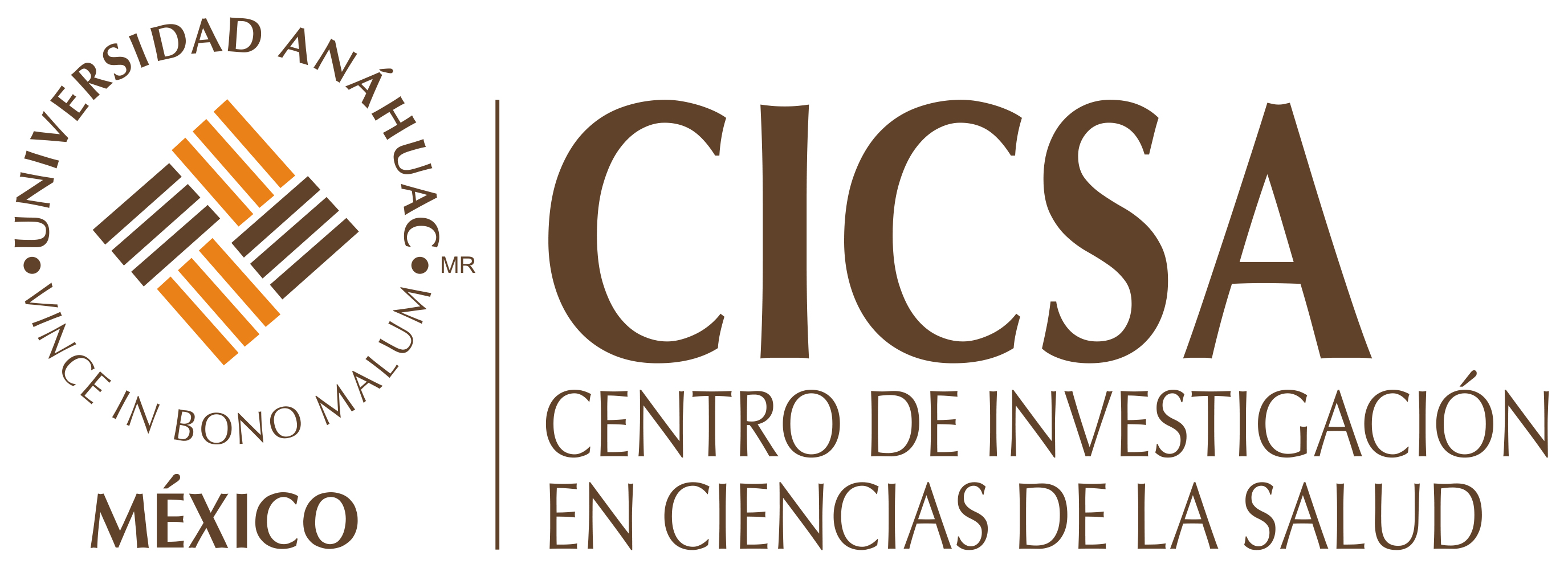Asymmetrical Septal Hypertrophy diagnosed by MRI: a case report
DOI:
https://doi.org/10.36105/psrua.2024v4n7.05Palabras clave:
hipertrofia septal asimétrica, sarcómero, muerte súbita, síncopeResumen
La hipertrofia septal asimétrica (HSA) se define como un aumento del grosor en la pared ventricular mayor a 15 mm que no está asociado a otra patología. Es una enfermedad que en la mayoría de los casos, tiene como etiología alguna mutación en uno de los genes asociados a las proteínas que forman el sarcómero. En el presente artículo presentamos un caso de HSA en un adulto de 43 años. Después de manifestar taquipnea, disnea y palidez cutánea, seguido de un síncope, acude a revisión. Durante la evaluación médica, se realiza un electrocardiograma (ECG) en el que se observa una bradicardia de 48 latidos por minuto y una onda T invertida en DI, AVL, V3, V4, V5 y V6. El diagnóstico se confirma mediante resonancia magnética cardiaca, que muestra una miocardiopatía hipertrófica con HSA no obstructiva de 27.22 mm. En consecuencia, se decide iniciar un tratamiento farmacológico con propranolol y se encuentra actualmente a la espera de tiempo quirúrgico para la colocación de un desfibrilador cardioversor implantable (DCI).
Descargas
Referencias
Schaufelberger M. Cardiomyopathy and pregnancy. Heart. 2019;105(20):1543-1551. https://pubmed.ncbi.nlm.nih.gov/31308064/ DOI: https://doi.org/10.1136/heartjnl-2018-313476
Gowda SN, Ali HJ, Hussain I. Overview of Restrictive Cardiomyopathies. Methodist Debakey Cardiovasc J. 2022;18(2):4-16. https://pubmed.ncbi.nlm.nih.gov/35414858/ DOI: https://doi.org/10.14797/mdcvj.1078
Sebastian SA, Panthangi V, Singh K, Rayaroth S, Gupta A, Shantharam D, Rasool BQ, Padda I, Co EL, Johal G. Hypertrophic Cardiomyopathy: Current Treatment and Future Options. Curr Probl Cardiol. 2023;48(4):101552. https://doi.org/10.1016/j.cpcardiol.2022.101552 DOI: https://doi.org/10.1016/j.cpcardiol.2022.101552
Biddinger KJ, Jurgens SJ, Maamari D, Gaziano L, Choi SH, Morrill VN, Halford JL, Khera AV, Lubitz SA, Ellinor PT, Aragam KG. Rare and Common Genetic Variation Underlying the Risk of Hypertrophic Cardiomyopathy in a National Biobank. JAMA Cardiol. 2022;7(7):715-722. https://doi.org/10.1001/jamacardio.2022.1061 DOI: https://doi.org/10.1001/jamacardio.2022.1061
Ottaviani A, Mansour D, Molinari LV, Galanti K, Mantini C, Khanji MY, Chahal AA, Zimarino M, Renda G, Sciarra L, Pelliccia F, Gallina S, Ricci F. Revisiting Diagnosis and Treatment of Hypertrophic Cardiomyopathy: Current Practice and Novel Perspectives. J Clin Med. 2023;12(17):5710. https://doi.org/10.3390/jcm12175710 DOI: https://doi.org/10.3390/jcm12175710
Litt MJ, Ali A, Reza N. Familial Hypertrophic Cardiomyopathy: Diagnosis and Management. Vasc Health Risk Manag. 2023;19:211-221. https://doi.org/10.2147/VHRM.S365001 DOI: https://doi.org/10.2147/VHRM.S365001
Kochi AN, Vettor G, Dessanai MA, Pizzamiglio F, Tondo C. Sudden cardiac death in athletes: From the basics to the practical work-up. Medicina. 2021;57(2):168. https://doi.org/10.3390/medicina57020168 DOI: https://doi.org/10.3390/medicina57020168
Márquez MF, Ruíz-Siller TJ, Méndez-Ramos R, Karabut E, Aranda-Fraustro A, Jiménez-Becerra S. Miocardiopatía hipertrófica (MCH). Una revisión histórica y anatomopatológica. Gac Med Mex. 2016;152(5):697-702. Available from: https://www.medigraphic.com/cgi-bin/new/resumen.cgi?IDARTICULO=68916
Veselka J, Anavekar NS, Charron P. Hypertrophic obstructive cardiomyopathy. Lancet. 2017;389(10075):1253-1267. https://doi.org/10.1016/S0140-6736(16)31321-6 DOI: https://doi.org/10.1016/S0140-6736(16)31321-6
Bayonas-Ruiz A, Muñoz-Franco FM, Sabater-Molina M, Oliva-Sandoval MJ, Gimeno JR, Bonacasa B. Current therapies for hypertrophic cardiomyopathy: a systematic review and meta-analysis of the literature. ESC Heart Fail. 2023;10(1):8-23. https://doi.org/10.1002/ehf2.14142 DOI: https://doi.org/10.1002/ehf2.14142
Ozdemir S, Tan YZ, Gazi E. Is the Increased Septal Perfusion the Signal of Asymmetrical Septal Hypertrophy? World J Nucl Med. 2016;15(3):184-9. https://doi.org/10.4103/1450-1147.174706 DOI: https://doi.org/10.4103/1450-1147.174706
Kuznetsov VA, Yaroslavskaya EI, Zyrianov IP, Kolunin GV, Krinochkin DV, Bessonova MI, Bessonov IS. Asymmetric septal hypertrophy in patients with coronary artery disease. Eur J Echocardiogr. 2010;11(8):698-702. https://doi.org/10.1093/ejechocard/jeq046 DOI: https://doi.org/10.1093/ejechocard/jeq046
Tuseth N, Cramariuc D, Rieck AE, Wachtell K, Gerdts E. Asymmetric septal hypertrophy - a marker of hypertension in aortic stenosis (a SEAS substudy). Blood Press. 2010;19(3):140-4. https://doi.org/10.3109/08037051.2010.481816 DOI: https://doi.org/10.3109/08037051.2010.481816
Melas M, Beltsios ET, Adamou A, Koumarelas K, McBride KL. Molecular Diagnosis of Hypertrophic Cardiomyopathy (HCM): In the Heart of Cardiac Disease. J Clin Med. 2022;12(1):225. https://doi.org/10.3390/jcm12010225 DOI: https://doi.org/10.3390/jcm12010225
Weissler-Snir A, Crean A, Rakowski H. The role of imaging in the diagnosis and management of hypertrophic cardiomyopathy. Expert Rev Cardiovasc Ther. 2016;14(1):51-74. https://doi.org/10.1586/14779072.2016.1113130 DOI: https://doi.org/10.1586/14779072.2016.1113130
Tschöpe C, Cooper LT, Torre-Amione G, Van Linthout S. Management of Myocarditis-Related Cardiomyopathy in Adults. Circ Res. 2019;124(11):1568-1583. https://doi.org/10.1161/CIRCRESAHA.118.313578 DOI: https://doi.org/10.1161/CIRCRESAHA.118.313578
Gragnano F, Pelliccia F, Guarnaccia N, Niccoli G, De Rosa S, Piccolo R, Moscarella E, Fabris E, Montone RA, Cesaro A, Porto I, Indolfi C, Sinagra G, Perrone Filardi P, Andò G, Calabrò P; Working Group of Interventional Cardiology of the Italian Society of Cardiology. Alcohol Septal Ablation in Patients with Hypertrophic Obstructive Cardiomyopathy: A Contemporary Perspective. J Clin Med. 2023;12(8):2810. https://doi.org/10.3390/jcm12082810 DOI: https://doi.org/10.3390/jcm12082810
Grillo MP, Erve JCL, Dick R, Driscoll JP, Haste N, Markova S, Brun P, Carlson TJ, Evanchik M. In vitro and in vivo pharmacokinetic characterization of mavacamten, a first-in-class small molecule allosteric modulator of beta cardiac myosin. Xenobiotica. 2019;49(6):718–733. https://doi.org/10.1080/00498254.2018.1495856 DOI: https://doi.org/10.1080/00498254.2018.1495856
Dong T, Alencherry B, Ospina S, Desai MY. Review of Mavacamten for Obstructive Hypertrophic Cardiomyopathy and Future Directions. Drug design, development and therapy. 2023;17, 1097–1106. https://doi.org/10.2147/DDDT.S368590 DOI: https://doi.org/10.2147/DDDT.S368590
Keam SJ. Mavacamten: First Approval. Drugs, 2022;82(10), 1127–1135. https://doi.org/10.1007/s40265-022-01739-7 DOI: https://doi.org/10.1007/s40265-022-01739-7
Heitner SB, Jacoby D, Lester, SJ, Owens A, Wang A, Zhang D, Lambing J, Lee J, Semigran M, Sehnert AJ. Mavacamten Treatment for Obstructive Hypertrophic Cardiomyopathy: A Clinical Trial. Annals of internal medicine, 2019;170(11), 741–748. https://doi.org/10.7326/M18-3016 DOI: https://doi.org/10.7326/M18-3016
Olivotto I, Oreziak A, Barriales-Villa R, Abraham TP, Masri A, Garcia-Pavia P, Saberi S, Lakdawala NK, Wheeler MT, Owens A, Kubanek M, Wojakowski W, Jensen MK, Gimeno-Blanes J, Afshar K, Myers J, Hegde S M, Solomon SD, Sehnert AJ, Zhang D, Li W, Bhattacharya M, Edelberg JM,Burstein-Waldman C, Lester SJ, Wang A, Ho CY, Jacoby D, EXPLORER-HCM study investigators. Mavacamten for treatment of symptomatic obstructive hypertrophic cardiomyopathy (EXPLORER-HCM): a randomised, double-blind, placebo-controlled, phase 3 trial. Lancet, 2020;396(10253):759–769. https://doi.org/10.1016/S0140-6736(20)31792-X DOI: https://doi.org/10.1016/S0140-6736(20)31792-X
Desai MY, Owens A, Geske JB, Wolski K, Naidu SS, Smedira NG, Cremer PC, Schaff H, McErlean E, Sewell C, Li W, Sterling L, Lampl K, Edelberg JM, Sehnert AJ, Nissen SE. Myosin inhibition in patients with obstructive hypertrophic cardiomyopathy referred for septal reduction therapy. J Am Coll Cardiol. 2022;80(2):95–108. https://doi.org/10.1016/j.jacc.2022.04.048 DOI: https://doi.org/10.1016/j.jacc.2022.04.048

Descargas
Publicado
Número
Sección
Licencia
Derechos de autor 2024 Mauricio Muleiro Álvarez, Felipe Esparza Salazar, Ángel David Alvarado Torres, María Fernanda Osorio Martínez

Esta obra está bajo una licencia internacional Creative Commons Atribución-NoComercial-SinDerivadas 4.0.
Todo el contenido intelectual que se encuentra en la presente publicación periódica se licencia al público consumidor bajo la figura de Creative Commons©, salvo que el autor de dicho contenido hubiere pactado en contrario o limitado dicha facultad a “Proceedings of Scientific Research Universidad Anáhuac. Multidisciplinary Journal of Healthcare©” o “Universidad Anáhuac México©” por escrito y expresamente.
Proceedings of Scientific Research Universidad Anáhuac. Multidisciplinary Journal of Healthcare se distribuye bajo una Licencia Creative Commons Reconocimiento-No comercial-Sin derivados 4.0 Internacional (CC BY-NC-ND 4.0).
El autor conserva los derechos patrimoniales sin restricciones y garantiza a la revista el derecho de ser la primera publicación del trabajo. El autor es libre de publicar en cualquier otro medio su artículo, como un repositorio institucional.














